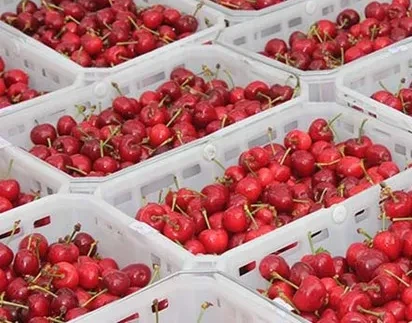Environmental conditions during the cherry flowering season are a crucial factor influencing seed set and, consequently, fruit set. The potential impact of this factor on reproductive success is likely to increase considering the effects induced by global warming.
In fact, for the sweet cherry, the Mediterranean area represents a borderline environment for its cultivation, and a further increase in temperatures could lead to a reduction in the area devoted to this crop. Pollen tube dynamics, which includes the time required for pollen germination and the pollen tube growth rate, is significantly affected by temperature.
Pollen germination is a highly variable parameter, whether it occurs between different species or between cultivars within the same species. In general, the optimal temperature range for pollen germination coincides with the average temperatures of the flowering period, and this relationship has been demonstrated in several fruit species.
Pollen tube growth, on the other hand, is promoted by temperatures in both herbaceous and woody species. The impact of temperature on pollen tube kinetics has been studied previously, but there is a lack of knowledge on how temperature affects pollen tube dynamics, particularly in terms of the population of male gametophytes that are able to reach the base of the style.
Therefore, the hypothesis of temperature influence on the male gametophyte population can be considered plausible, but still not supported by scientific data. Therefore, the study conducted in experimental orchards in Zaragoza (Spain) by researchers from the Fruit Tree Crops Unit aimed to evaluate the impact of temperature on pollen kinetics in cherry trees.
Specifically, two cultivars with different levels of adaptation to temperature were compared as pollen donors. The cultivar known as 'Sunburst' originated in Canada and can be counted among the northern European cultivars. The cultivar 'Cristobalina,' on the other hand, is native to southeastern Spain and has adapted to thrive in warmer climatic conditions.
The effects of temperature were evaluated by experiments conducted in temperature-controlled chambers and in the field using plastic structures to cover the trees. The results show that optimal temperatures for pollen germination, pollen tube kinetics and pollen dynamics exhibit variation, indicating the presence of distinct regulatory mechanisms.
Increasing temperature resulted in a decrease in germination rate, but also in an acceleration of pollen tube growth rate within the style. In both genotypes, higher temperature caused a decrease in pollen germination while promoting the growth rate of pollen tubes.

The pollen tubes of Cristobalina showed a higher rate of reaching the base of the style of all flowers, compared to Sunburst, at the three temperatures examined (10°C, 20°C and 30°C). It is worth noting that the pollen tube growth rates of the Cristobalina species remained fairly constant at both 20°C and 30°C.
In contrast, the Sunburst species showed a significant increase in its growth rate precisely at 30°C. This variation suggests that adaptation to pollen donor temperature plays an important role in determining the observed effects. The observed decline in germination rates of both paternal genotypes with increasing temperature can potentially be attributed to the broader adaptation of sweet cherry to colder temperatures.
The results of this study suggest that there is variation in genetic response to temperature during the reproductive phase. This variation may have significant implications for the ability of plant species to adapt to sudden changes in temperature.
Sourcee: Hedhly, A., Hormaza, J.I. and Herrero, M. (2004), Effect of temperature on pollen tube kinetics and dynamics in sweet cherry, Prunus avium (Rosaceae) . Am. J. Bot., 91: 558-564. https://doi.org/10.3732/ajb.91.4.558
Melissa Venturi
University of Bologna (IT)
Cherry Times - All rights reserved












